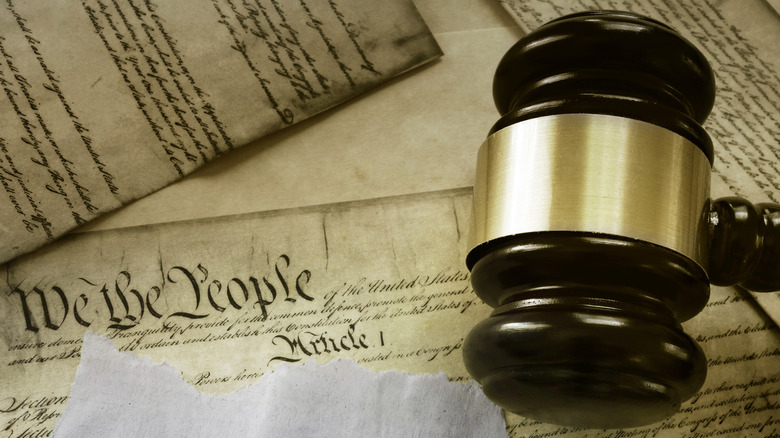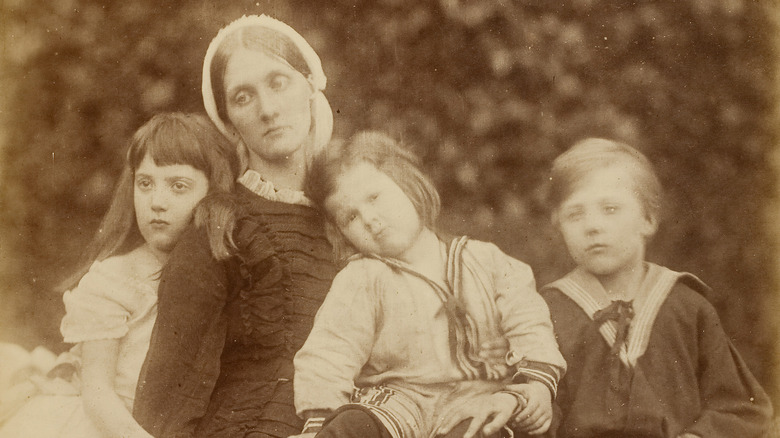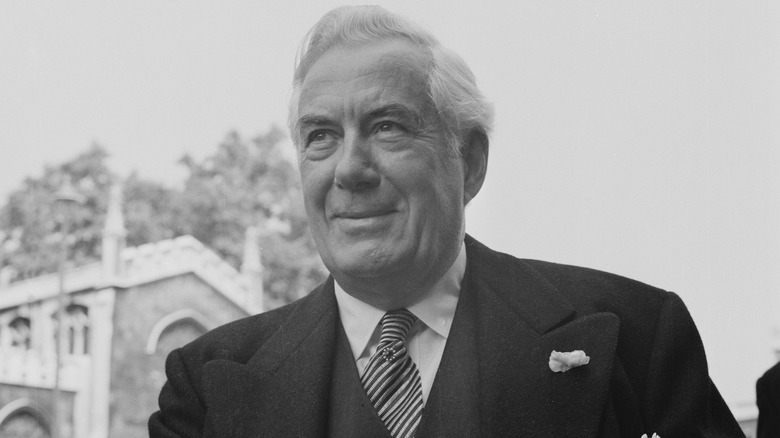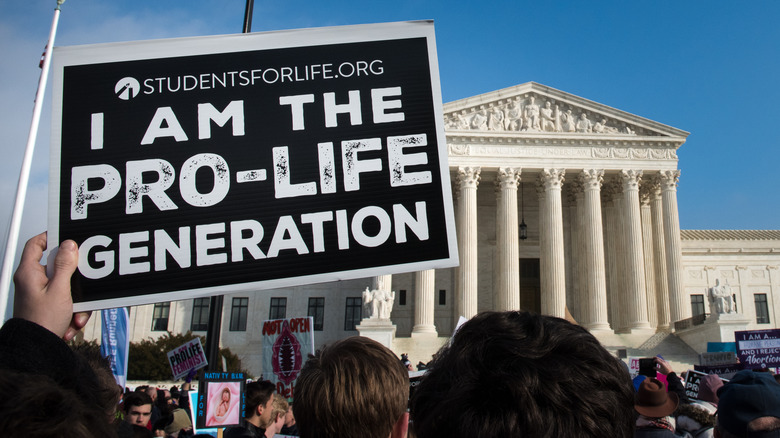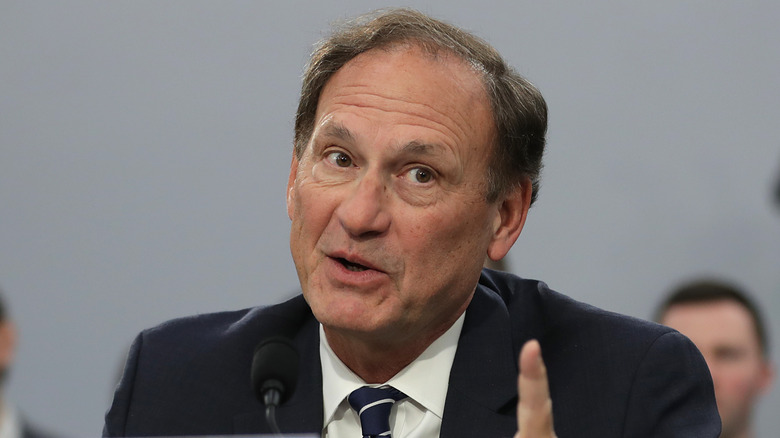What Do We Know About The Supreme Court Case That Could Overturn Roe V Wade?
In early May, a first draft majority opinion from the Supreme Court of the United States in the case Dobbs v. Jackson Women's Health Organization was leaked to Politico. In the document, the Supreme Court seemed ready to overturn Roe v. Wade, a landmark 1973 case protecting a woman's right to an abortion, as The Guardian explains. The court's Roe v. Wade decision has been hotly debated and contested ever since, a flashpoint for activists on both sides of the abortion issue.
Politico stresses that the document (posted online) is a draft, not a final decision. Justices have been known to change their votes in the leadup to issuing a decision. In Dobbs, that decision isn't expected for about two months.
The potential overturning of Roe V. Wade is not unexpected from the conservative-leaning Supreme Court as it now stands, according to Reuters. What was it, though, about Dobbs v. Jackson Women's Health Organization that made this the right time to take action? The Dobbs case, in particular, asks one of the most critical questions in the abortion debate: When exactly is a pregnancy viable? If Roe v. Wade is overturned by the SCOTUS, that answer could vary between states.
Abortion rights throughout history
Women were choosing abortion for a number of reasons prior to Roe v. Wade. In the colonial period, abortions were a common enough medical procedure, according to the Center for American Progress (CAP). The first laws regulating abortion did not show up in America until the 1820s. Abortion bans after "quickening" — or when the kick of an unborn child can first be felt — did not come about until the 1860s. Quickening can happen anywhere from 14 to 26 weeks (via CAP). The Dobbs v. Jackson Women's Health Organization case currently before the Supreme Court would ban abortions after just 15 weeks (via Oyez).
By 1910, abortions, except to save a woman's life in certain instances, were all but banned. At that point, the American Medical Association, the Catholic Church, and certain members of the media advocated for the criminalization of abortion. Women were waiting longer to start families and having fewer children, worsening the rates of abortion at the time, according to those who supported banning the practice. From that point, abortion would remain largely illegal until the 1970s and Roe v. Wade.
What is Roe v. Wade?
In 1973, Roe v. Wade was passed in a 7 to 2 decision by the Supreme Court under Chief Justice Warren E. Burger (pictured). Because of the ruling, no state would be allowed to restrict the right to end a pregnancy within the first trimester, as The Guardian explains. The Roe v. Wade case was brought by a woman in Texas who sought an abortion. Abortions were banned in Texas at that time, and plaintiff in Roe v. Wade claimed she was unable to travel outside her state to receive one. For this reason, the Texas law banning abortions violated her Constitutional rights, or so the case claimed. In this instance, the Supreme Court agreed.
Through Roe v. Wade, the right to an abortion was couched in terms of privacy. The state had no right to interfere with a woman's decision to end a pregnancy, based on the ruling. The decision read (via The Guardian): "The detriment that the State would impose upon the pregnant woman by denying this choice altogether is apparent." The ruling also found the Texas law to be overly broad. The decision to end a pregnancy in the first trimester would be left to a woman and her healthcare provider, according to Roe v. Wade. Almost immediately after the ruling, the decision became controversial, though. In 1992, the Supreme ruling Planned Parenthood v. Casey reinforced their stance.
What might happen if Roe v. Wade is overturned?
Should Roe v. Wade be overturned, as it appears it will be, based on the leaked draft majority decision published through Politico, several states that have recently passed laws restricting abortions before the first trimester will be allowed to enforce them, according to NPR. An overturned Roe v. Wade may also embolden additional states to pass similar legislation. Some states have already passed so-called "trigger laws" related to abortion, or laws that were passed knowing they were unconstitutional per Roe v. Wade, but would take effect should that 1973 SCOTUS ruling be overturned.
An overturned Roe v. Wade would not necessarily mean abortion would be illegal everywhere. In the build-up to the SCOTUS leaked draft opinion, several states supportive of abortion rights took steps to ensure abortion would stay legal within their borders. Some also prepared for women to travel from neighboring states where abortion might end up banned. An uptick in negative health consequences for women is also anticipated. Women of color, who historically have abortions at higher rates, are especially vulnerable to the long-term consequences related to banning abortion.
The leaked draft opinion
The leaked draft of the SCOTUS majority opinion that signaled the potential overturning of Roe v. Wade was written by Associate Supreme Court Justice Samuel Alito (pictured). As was expected, other conservative-leaning justices such as Clarence Thomas, Neil Gorsuch, Brett Kavanaugh, and Amy Coney Barrett seem ready to support it, as Politico reports. Historically liberal justices Stephen Breyer, Sonia Sotomayor, and Elena Kagan are expected to dissent. A potential swing vote remains SCOTUS Chief Justice John Roberts.
Once the draft opinion was published, Roberts was quick to make clear that it was not a final decision, and that details included in the draft could change before an official ruling comes from the court. The fact that the draft was leaked in the first place is a betrayal, and undermines the court's integrity, Roberts went on to explain. "This was a singular and egregious breach of that trust that is an affront to the Court and the community of public servants who work here," Roberts wrote (via Politico). Though rare, other draft opinions from the SCOTUS have been leaked throughout history.
What is Dobbs v. Jackson Women's Health Organization?
The crux of the Dobbs v. Jackson Women's Health Organization case is when exactly a pregnancy becomes viable. In 2018, Mississippi ruled to ban abortions after 15 weeks through the state's "Gestational Age Act" passed by voters. As a result, all abortions would be prohibited in the state, save for only for a few exceptions (via Oyez). It's generally agreed by medical professionals that pregnancies are viable only after 24 to 28 weeks, and that a baby born prior to that time frame is unlikely to survive outside the mother. Many studies have settled on different points of viability on either side of the issue, according to The Washington Post.
After passing Mississippi's "Gestational Age Act" a temporary restraining order was brought by the Jackson Women's Health Organization. Under Roe v. Wade, a 15-week abortion ban is unconstitutional. For this reason, Justice Alito and his conservative colleagues may feel the timing is right to reverse the ruling. As Alito wrote in his draft majority opinion (via Politico), "Roe was egregiously wrong from the start. Its reasoning was exceptionally weak, and the decision has had damaging consequences. And far from bringing about a national settlement of the abortion issue, Roe and [Planned Parenthood v. Casey] have enflamed debate and deepened division."
